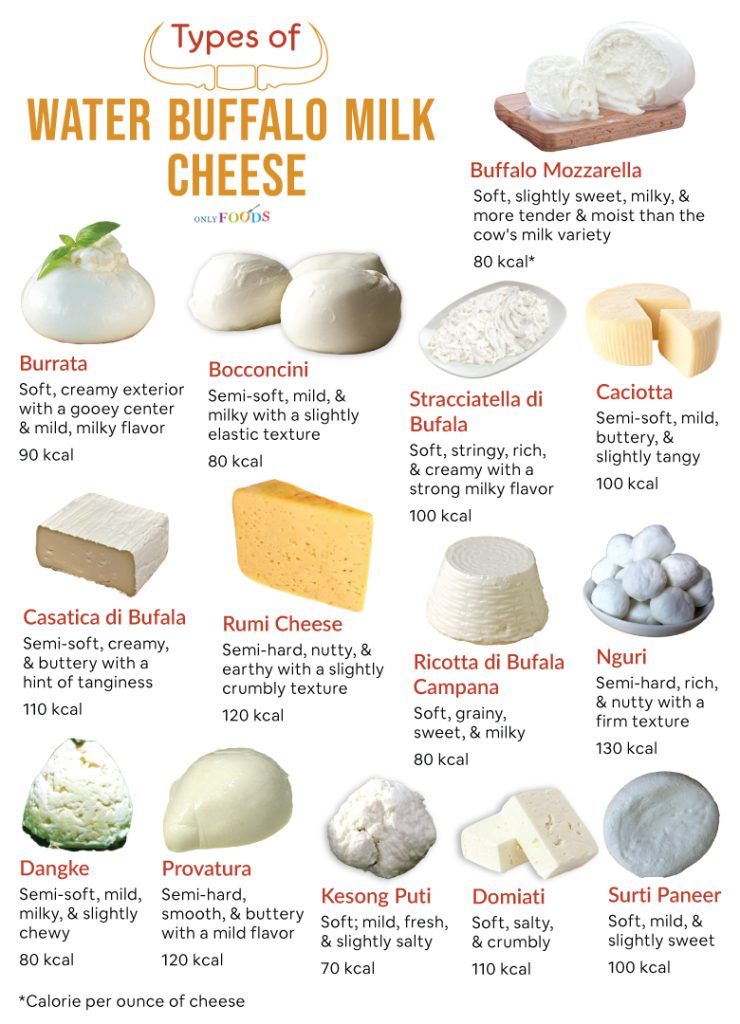Types of Water Buffalo Cheese
Any cheese made from the milk of a water buffalo is a buffalo cheese. In the United States, the term is commonly associated with buffalo mozzarella, a popular soft and flavorful cheese. However, buffalo milk cheeses are just as diverse and versatile as those made from goat or sheep milk, offering a range of varieties.
While many of these may be less familiar in the United States, they can occasionally be found in specialty stores and valued as novelties. These cheeses typically boast a soft or semi-soft texture, making them perfect for savoring on their own, pairing with fresh fruits, or adding to salads.
What Makes Buffalo Milk Cheese Different
Buffalo milk closely resembles cow’s milk but with significantly higher fat, phosphorus, calcium, iron, and protein levels. It also has some distinct nutty and acidic tones, but the two are otherwise similar in terms of flavors. This similarity allows any cheese crafted from buffalo milk to sidestep the need for extensive aging, as there are no odd, ‘goaty’, or potentially unpleasant tastes to mellow out.
The unique characteristics of buffalo milk cheeses are best preserved in their delicate and creamy state, making extended aging counterproductive. Hence, almost all buffalo cheeses come in soft or semi-soft varieties, having a short shelf-life.
Different Types of Water Buffalo Milk Cheese
| Name | Texture and Taste | Country of Origin | Calories/oz. | How to Eat |
|---|---|---|---|---|
| Burrata | Soft, creamy exterior with a gooey center and mild, milky flavor | Italy | ~90 kcal | With fresh tomatoes, basil, olive oil, balsamic vinegar, and crusty bread |
| Bocconcini | Semi-soft, mild, and milky with a slightly elastic texture | Italy | ~80 kcal | In Caprese salad or with pasta dishes |
| Buffalo Mozzarella | Soft, much more tender and moist than the cow’s milk variety, with a delicate, milky, and slightly sweet taste | Italy | ~80 kcal | In pizza, salads, and sandwiches |
| Stracciatella di Bufala | Soft, stringy, rich, and creamy with a strong milky flavor | Italy | ~100 kcal | With toasted bread, tomatoes, olive oil, and prosciutto |
| Caciotta | Semi-soft, mild, buttery, and slightly tangy | Italy | ~100 kcal | With crackers, figs, honey, and cured meats |
| Kesong Puti | Soft; mild, fresh, and slightly salty | Philippines | ~70 kcal | With pandesal (Filipino bread rolls), fruits, and traditional rice cake dishes from the Philippines |
| Rumi Cheese | Semi-hard, nutty, and earthy with a slightly crumbly texture | Turkey | ~120 kcal | With Turkish flatbread, honey, dried fruits, and walnuts |
| Casatica di Bufala | Semi-soft, creamy, and buttery with a hint of tanginess | Italy | ~110 kcal | With pear slices, honey, baguette, and olives |
| Nguri | Semi-hard, rich, and nutty with a firm texture | Nepal | ~130 kcal | With traditional flatbreads, chutney, grapes, and walnuts |
| Dangke | Semi-soft, mild, milky, and slightly chewy | Indonesia | ~80 kcal | With rice cakes, spicy sauces, and fruits like pineapple |
| Domiati | Soft, salty, and crumbly | Egypt | ~110 kcal | With flatbreads, olives, and cucumbers |
| Provatura | Semi-hard, smooth, and buttery with a mild flavor | Italy | ~120 kcal | With grilled vegetables, Italian bread, and cured meats |
| Ricotta di Bufala Campana | Soft, grainy, sweet, and milky | Italy | ~80 kcal | With fresh berries or in dishes like cannoli, pasta, and various desserts |
| Surti Paneer | Soft, mild, and slightly sweet | India | ~100 kcal | In Indian curries, spinach dishes, and desserts |
FAQ
Buffalo milk contains lower amounts of lactose than cow’s milk, leading to the cheese having reduced lactose content as well. To cater to individuals with lactose intolerance, many producers employ specific cheesemaking processes to diminish lactose in their products further. It’s advisable to check the product label or inquire directly with the manufacturer to confirm that a cheese is safe for those with lactose intolerance.

